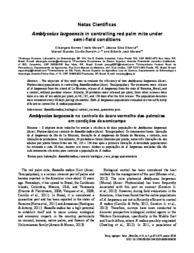Amblyseius largoensis in controlling red palm mite under semi-field conditions.
Amblyseius largoensis in controlling red palm mite under semi-field conditions.
Author(s): MORAIS, E. G. F. de; OLIVEIRA, J. S.; GONDIM JR. M. G. C.; MORAES, G. J.
Summary: The objective of this work was to evaluate the efficiency of two Amblyseius largoensis (Acari:Phytoseiidae) populations in controlling Raoiella indica (Acari: Tenuipalpidae). The treatments were: release of A. largoensis from the island of La Réunion; release of A. largoensis from the state of Roraima, Brazil; and a control, without predator release. Initially, 20 predators were released per plant; three other releases were done at a rate of ten adults per plant, at 46, 135, and 156 days after the first release. The population densities were estimated every 20 days, during six months. Both A. largoensis populations evaluated are not sufficiently efficient to control the R. indica population.
Publication year: 2016
Types of publication: Journal article
Unit: Embrapa Roraima
Observation
Some of Embrapa's publications are published as ePub files. To read them, use or download one of the following free software options to your computer or mobile device. Android: Google Play Books; IOS: iBooks; Windows and Linux: Calibre.
Access other publications
Access the Agricultural Research Database (BDPA) to consult Embrapa's full library collection and records.
Visit Embrapa Bookstore to purchase books and other publications sold by Embrapa.

